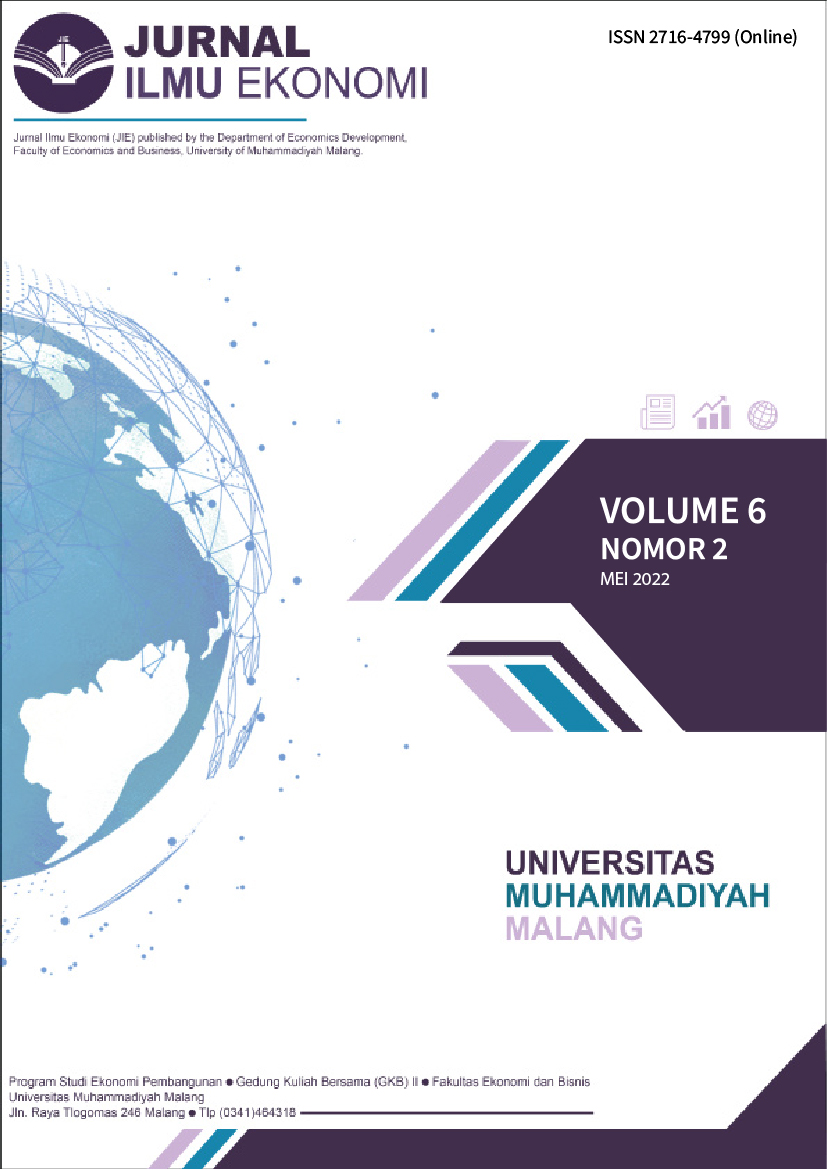Analisis Pengaruh TPT, UMP, Pertumbuhan Ekonomi, IPM Terhadap Jumlah Penduduk Miskin Pulau Jawa
DOI:
https://doi.org/10.22219/jie.v6i2.20626Keywords:
Open Unemployment Rate, , Provincial Minimum Wage , , Economic Growth, Human Development Index, Number of Poor PopulationAbstract
The purpose of this study was to determine the effect of the Open Unemployment Rate, Provincial Minimum Wage, Economic Growth and Human Development Index on the Number of Poor Populations partially and simultaneously in Java. This study uses panel data regression analysis. The results of the study show that the Open Unemployment Rate has a positive and significant effect on the number of poor people on the island of Java. The minimum wage has a negative and significant effect on the number of poor people in Java. Economic growth has a positive and insignificant effect on the number of poor people on the island of Java. The human development index has a negative and significant effect on the Number of Poor Populations in Java Island 2012 – 2020
Downloads
References
Badan Pusat Statistik. (2020). Jumlah Penduduk Miskin (Ribu Jiwa) Menurut Kabupaten/Kota 2020. https://www.bps.go.id/indicator/23/619/1/jumlah-penduduk-miskin-ribu-jiwa-menurut-kabupaten-kota-.html
Cholili, F. M. (2014). Analisa Pengaruh Pengangguran, Produk Domestik Regional Bruto (PDRB), dan Indeks Pembangunan Manusia (IPM) Terhadap Jumlah Penduduk Miskin (Studi Kasus 33 Provinsi di Indonesia). Journal of Chemical Information and Modeling, 53(9), 1–14.
Fitriani. (2016). Analisis Pengaruh Upah Minimum dan Tingkat Pengangguran Terhadap Jumlah Penduduk Miskin di Provinsi Aceh. Universitas Teuku Umar Meulaboh, Aceh Barat.
Harlik,amri amir, hardiani. (2013). Faktor-Faktor yang Mempengaruhi Kemiskinan dan Pengangguran di Kota Jambi. Jurnal Perspektif Pembiayaan Dan Pembangunan Daerah, 1(2), 109–120.
Harya, G. I. (2019). Analisis Profil Kemiskinan Makro Kabupaten Mojokerto. Jurnal Ilmiah Sosial Agribisnis, 19(1), 1–17.
Ningrum, S. S. (2017). Analisis Pengaruh Tingkat Pengangguran Terbuka, Indeks Pembangunan Manusia, dan Upah Minimum Terhadap Jumlah Penduduk Miskin di Indonesia Tahun 2011-2015. Jurnal Ekonomi Pembangunan, 15(2), 184–192. https://doi.org/10.22219/jep.v15i2.5364
Prastyo, A. A. (2010). Analisis Faktor-Faktor Yang Mempengaruhi Tingkat Kemiskinan (Studi Kasus 35 Kabupaten/Kota di Jawa Tengah Tahun 2003-2007). Universitas Diponegoro.
Saparuddin Mukhtar, Ari Saptono, A. S. A. (2019). Analisis Pengaruh Indeks Pembangunan Manusia dan Tingkat Pengangguran Terbuka Terhadap Kemiskinan di Indonesia. Jurnal Ecoplan, 2(2), 77–89.
Sukirno, S. (2011). Makroekonomi Teori Pengantar (Ketiga). Rajawali Pers.
Sukmawati, A. K. P. & U. S. (2018). Analisis Pengaruh Indeks Pembangunan Manusia Tenaga Kerja dan Kemiskinan Terhadap Pertumbuhan Ekonomi. EQUILIBRIUM: Jurnal Ekonomi Syariah, 6(2), 217–240. http://eprints.ums.ac.id/80956/
Suliswanto, M. S. W. (2010). Pengaruh Produk Domestik Bruto (Pdb) dan Indeks Pembangunan Manusia (Ipm) Terhadap Angka Kemiskinan di Indonesia. Jurnal Ekonomi Pembangunan, 8(2), 1–10.
Suryawati, C. (2005). Memahami Kemiskinan Secara Multidimensional. Jurnal Manajemen Pelayanan Kesehatan, 08(03), 121–129.
Todaro, M. P. (2003). Pembangunan Ekonomi di Dunia Ketiga (Edisi 8). Erlangga.
Utami, H. W., & Masjkuri, S. U. (2018). Pengaruh Pertumbuhan Ekonomi, Upah Minimum, Tingkat Pengangguran Terbuka dan Pendidikan Terhadap Jumlah Penduduk Miskin Kabupaten/Kota di Provinsi Jawa Timur Tahun 2008-2013. EKOSIANA: Jurnal Ekonomi Syari’ah, 4(1), 11–20. https://doi.org/10.30957/ekosiana.v4i01.41
Yacoub, Y. (2012). Pengaruh Tingkat Pengangguran terhadap Tingkat Kemiskinan Kabupaten / Kota di Provinsi Kalimantan Barat. Jurnal EKSOS, 8(3), 1–10.
Downloads
Published
How to Cite
Issue
Section
License
Copyright (c) 2022 Kevin Dwi Prassetyo, Zainal Arifin

This work is licensed under a Creative Commons Attribution-ShareAlike 4.0 International License.
Authors who publish with this journal agree to the following terms:
- For all articles published in the JIE (Jurnal Ilmu Ekonomi), copyright is retained by the authors. Authors give permission to the publisher to announce the work with conditions. When the manuscript is accepted for publication, the authors agree to the automatic transfer of non-exclusive publishing rights to the publisher.
- Authors retain copyright and grant the journal right of first publication with the work simultaneously licensed under a Creative Commons Attribution-NonCommercial-ShareAlike 4.0 International License that allows others to share the work with an acknowledgement of the work's authorship and initial publication in this journal.
- Authors are able to enter into separate, additional contractual arrangements for the non-exclusive distribution of the journal's published version of the work (e.g., post it to an institutional repository or publish it in a book), with an acknowledgement of its initial publication in this journal.
- Authors are permitted and encouraged to post their work online (e.g., in institutional repositories or on their website) prior to and during the submission process, as it can lead to productive exchanges, as well as earlier and greater citation of published work (See The Effect of Open Access).
This is an open access article and licensed under a Creative Commons Attribution-NonCommercial-ShareAlike 4.0 International License








